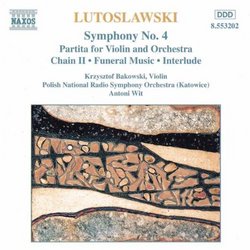| All Artists: Witold Lutoslawski, Antoni Wit, Polish Radio Orchestra & Chorus Katowice, Polish Radio Symphony Orchestra Title: Lutoslawski: Symphony No. 4; Partita for Violin & Orchestra Members Wishing: 0 Total Copies: 0 Label: Naxos Release Date: 9/17/1996 Genre: Classical Styles: Forms & Genres, Concertos, Historical Periods, Modern, 20th, & 21st Century, Instruments, Strings, Symphonies Number of Discs: 1 SwapaCD Credits: 1 UPCs: 730099420228, 073009942022 |
Search - Witold Lutoslawski, Antoni Wit, Polish Radio Orchestra & Chorus Katowice :: Lutoslawski: Symphony No. 4; Partita for Violin & Orchestra
 | Witold Lutoslawski, Antoni Wit, Polish Radio Orchestra & Chorus Katowice Lutoslawski: Symphony No. 4; Partita for Violin & Orchestra Genre: Classical This fine disc not only contains Lutoslawski's last major work, the compact and elegiac Fourth Symphony, it neatly gathers his two pieces for violin and orchestra, Chain II and the Partita. Like most Polish composers, Luto... more » |
Larger Image |
CD DetailsSynopsis
Amazon.com This fine disc not only contains Lutoslawski's last major work, the compact and elegiac Fourth Symphony, it neatly gathers his two pieces for violin and orchestra, Chain II and the Partita. Like most Polish composers, Lutoslawski had a natural feeling for the violin, and although he never wrote a formal violin concerto, the Partita in particular certainly fits the bill. Like all of his best work, the music is modern in tone, but so lucidly structured and sonically eventful that, while it's certainly not easy listening, no sympathetic ear can fail to be impressed by its beauty and emotional directness. The performances, by the composer's compatriots, are all superb, and this budget-price disc is part of survey of the composer's complete orchestral music. Wonderful. --David Hurwitz Similar CDs
Similarly Requested CDs
|
CD ReviewsSuperb 'Funeral Music' and breathtaking Fourth Symphony Dan Albertson | Highland, MI USA | 01/31/2000 (5 out of 5 stars) "This disc would serve as a wonderful introduction to the music of this late Polish master to those who have yet to be delighted by his music. The disc begins with his haunting, elegiac 'Funeral Music,' scored for strings only, with a solo cello mournfully playing its beginning and its conclusion. This recording is an absolute must, for only the composer's own recording can top it, and not by much. Next, 'Chain II' is given a supreme performance by Krzysztof Bakowski, a performance that is equal to or maybe even better than Anne-Sophie Mutter's (he wrote it for her). The calm and graceful 'Interlude' is brilliantly scored, and serves as a very effective transition piece. The 'Partita,' once more featuring Bakowski, is given its essential performance. Finally, Lutoslawski's swansong, his Fourth Symphony, is given a performance that probably can't ever be topped. Conductor Antoni Wit brings so much life and energy to it, and it is recorded with such a great sound, that it quickly becomes permanently embedded in your mind. Of course, its wonderful scoring and thick textures help too! Lutoslawski's oeuvre is among the most formidable of 20th century composers. He wrote so much wonderful music, and the pieces showcased here are a great introduction to it." Great value and a good listen Rinchen Choesang | Melbourne, Australia | 02/29/2004 (4 out of 5 stars) "I make no attempt to compare this with other versions of these pieces, as I haven't listened to any others. This CD, like the others in this series is great value. The issue mentioned in a previous review about Chain, the Partita and the Interlude being reversed in their usual order isn't problematic, as they all stand alone and can be programmed in the 'right' order anyway.This is all fine music, but the highlights for me are the Funeral Music and Interlude. Their 'atmospheric' nature appeals.For those interested in low price versions of Polish 20th Century masters, try:Penderecki: Anaklasis/Threnody for the Victims of Hiroshima/De Natura Sonoris Nos 1 & 2 etc on EMI ClassicsGorecki: The glorious Symphony No 3 on Naxos - at least equal best of all versions and my favourite" Stunning performances K. Busch | Medford, MA USA | 02/06/2003 (5 out of 5 stars) "I have listened to this disk over and over -- something I rarely do. The Fourth Symphony is exciting in Wit's hands. I prefer it to Esa-Pekka Salonen's outing with the LA Philharmonic. The Funeral Music is moving and the Chain II/Interlude/Partita sequence rewarding."
|








